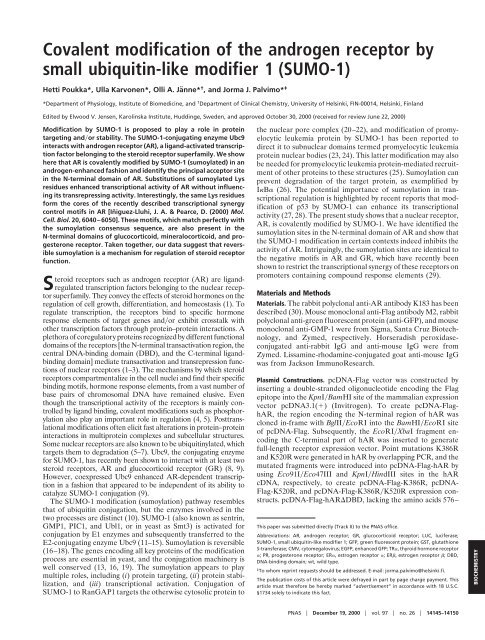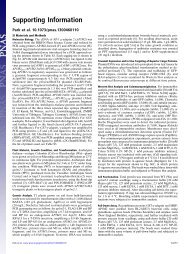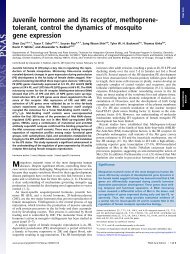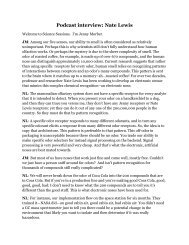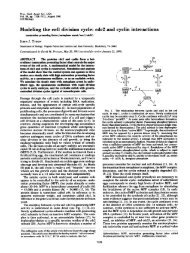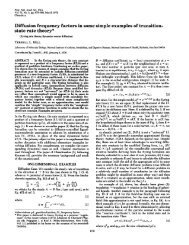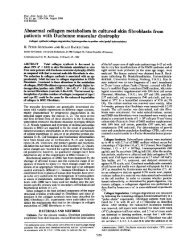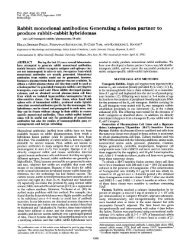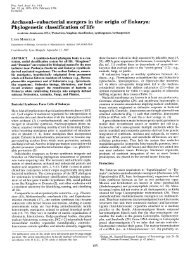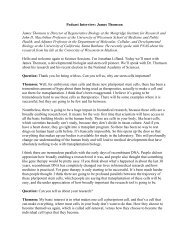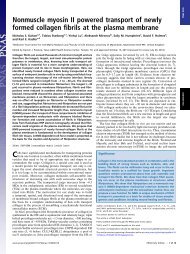SUMO-1 - Proceedings of the National Academy of Sciences
SUMO-1 - Proceedings of the National Academy of Sciences
SUMO-1 - Proceedings of the National Academy of Sciences
You also want an ePaper? Increase the reach of your titles
YUMPU automatically turns print PDFs into web optimized ePapers that Google loves.
Covalent modification <strong>of</strong> <strong>the</strong> androgen receptor by<br />
small ubiquitin-like modifier 1 (<strong>SUMO</strong>-1)<br />
Hetti Poukka*, Ulla Karvonen*, Olli A. Jänne* † , and Jorma J. Palvimo* ‡<br />
*Department <strong>of</strong> Physiology, Institute <strong>of</strong> Biomedicine, and † Department <strong>of</strong> Clinical Chemistry, University <strong>of</strong> Helsinki, FIN-00014, Helsinki, Finland<br />
Edited by Elwood V. Jensen, Karolinska Institute, Huddinge, Sweden, and approved October 30, 2000 (received for review June 22, 2000)<br />
Modification by <strong>SUMO</strong>-1 is proposed to play a role in protein<br />
targeting and�or stability. The <strong>SUMO</strong>-1-conjugating enzyme Ubc9<br />
interacts with androgen receptor (AR), a ligand-activated transcription<br />
factor belonging to <strong>the</strong> steroid receptor superfamily. We show<br />
here that AR is covalently modified by <strong>SUMO</strong>-1 (sumoylated) in an<br />
androgen-enhanced fashion and identify <strong>the</strong> principal acceptor site<br />
in <strong>the</strong> N-terminal domain <strong>of</strong> AR. Substitutions <strong>of</strong> sumoylated Lys<br />
residues enhanced transcriptional activity <strong>of</strong> AR without influencing<br />
its transrepressing activity. Interestingly, <strong>the</strong> same Lys residues<br />
form <strong>the</strong> cores <strong>of</strong> <strong>the</strong> recently described transcriptional synergy<br />
control motifs in AR [Iñiguez-Lluhi, J. A. & Pearce, D. (2000) Mol.<br />
Cell. Biol. 20, 6040–6050]. These motifs, which match perfectly with<br />
<strong>the</strong> sumoylation consensus sequence, are also present in <strong>the</strong><br />
N-terminal domains <strong>of</strong> glucocorticoid, mineralocorticoid, and progesterone<br />
receptor. Taken toge<strong>the</strong>r, our data suggest that reversible<br />
sumoylation is a mechanism for regulation <strong>of</strong> steroid receptor<br />
function.<br />
Steroid receptors such as androgen receptor (AR) are ligandregulated<br />
transcription factors belonging to <strong>the</strong> nuclear receptor<br />
superfamily. They convey <strong>the</strong> effects <strong>of</strong> steroid hormones on <strong>the</strong><br />
regulation <strong>of</strong> cell growth, differentiation, and homeostasis (1). To<br />
regulate transcription, <strong>the</strong> receptors bind to specific hormone<br />
response elements <strong>of</strong> target genes and�or exhibit crosstalk with<br />
o<strong>the</strong>r transcription factors through protein–protein interactions. A<br />
plethora <strong>of</strong> coregulatory proteins recognized by different functional<br />
domains <strong>of</strong> <strong>the</strong> receptors [<strong>the</strong> N-terminal transactivation region, <strong>the</strong><br />
central DNA-binding domain (DBD), and <strong>the</strong> C-terminal ligandbinding<br />
domain] mediate transactivation and transrepression functions<br />
<strong>of</strong> nuclear receptors (1–3). The mechanisms by which steroid<br />
receptors compartmentalize in <strong>the</strong> cell nuclei and find <strong>the</strong>ir specific<br />
binding motifs, hormone response elements, from a vast number <strong>of</strong><br />
base pairs <strong>of</strong> chromosomal DNA have remained elusive. Even<br />
though <strong>the</strong> transcriptional activity <strong>of</strong> <strong>the</strong> receptors is mainly controlled<br />
by ligand binding, covalent modifications such as phosphorylation<br />
also play an important role in regulation (4, 5). Posttranslational<br />
modifications <strong>of</strong>ten elicit fast alterations in protein–protein<br />
interactions in multiprotein complexes and subcellular structures.<br />
Some nuclear receptors are also known to be ubiquitinylated, which<br />
targets <strong>the</strong>m to degradation (5–7). Ubc9, <strong>the</strong> conjugating enzyme<br />
for <strong>SUMO</strong>-1, has recently been shown to interact with at least two<br />
steroid receptors, AR and glucocorticoid receptor (GR) (8, 9).<br />
However, coexpressed Ubc9 enhanced AR-dependent transcription<br />
in a fashion that appeared to be independent <strong>of</strong> its ability to<br />
catalyze <strong>SUMO</strong>-1 conjugation (9).<br />
The <strong>SUMO</strong>-1 modification (sumoylation) pathway resembles<br />
that <strong>of</strong> ubiquitin conjugation, but <strong>the</strong> enzymes involved in <strong>the</strong><br />
two processes are distinct (10). <strong>SUMO</strong>-1 (also known as sentrin,<br />
GMP1, PIC1, and Ubl1, or in yeast as Smt3) is activated for<br />
conjugation by E1 enzymes and subsequently transferred to <strong>the</strong><br />
E2-conjugating enzyme Ubc9 (11–15). Sumoylation is reversible<br />
(16–18). The genes encoding all key proteins <strong>of</strong> <strong>the</strong> modification<br />
process are essential in yeast, and <strong>the</strong> conjugation machinery is<br />
well conserved (13, 16, 19). The sumoylation appears to play<br />
multiple roles, including (i) protein targeting, (ii) protein stabilization,<br />
and (iii) transcriptional activation. Conjugation <strong>of</strong><br />
<strong>SUMO</strong>-1 to RanGAP1 targets <strong>the</strong> o<strong>the</strong>rwise cytosolic protein to<br />
<strong>the</strong> nuclear pore complex (20–22), and modification <strong>of</strong> promyelocytic<br />
leukemia protein by <strong>SUMO</strong>-1 has been reported to<br />
direct it to subnuclear domains termed promyelocytic leukemia<br />
protein nuclear bodies (23, 24). This latter modification may also<br />
be needed for promyelocytic leukemia protein-mediated recruitment<br />
<strong>of</strong> o<strong>the</strong>r proteins to <strong>the</strong>se structures (25). Sumoylation can<br />
prevent degradation <strong>of</strong> <strong>the</strong> target protein, as exemplified by<br />
I�B� (26). The potential importance <strong>of</strong> sumoylation in transcriptional<br />
regulation is highlighted by recent reports that modification<br />
<strong>of</strong> p53 by <strong>SUMO</strong>-1 can enhance its transcriptional<br />
activity (27, 28). The present study shows that a nuclear receptor,<br />
AR, is covalently modified by <strong>SUMO</strong>-1. We have identified <strong>the</strong><br />
sumoylation sites in <strong>the</strong> N-terminal domain <strong>of</strong> AR and show that<br />
<strong>the</strong> <strong>SUMO</strong>-1 modification in certain contexts indeed inhibits <strong>the</strong><br />
activity <strong>of</strong> AR. Intriguingly, <strong>the</strong> sumoylation sites are identical to<br />
<strong>the</strong> negative motifs in AR and GR, which have recently been<br />
shown to restrict <strong>the</strong> transcriptional synergy <strong>of</strong> <strong>the</strong>se receptors on<br />
promoters containing compound response elements (29).<br />
Materials and Methods<br />
Materials. The rabbit polyclonal anti-AR antibody K183 has been<br />
described (30). Mouse monoclonal anti-Flag antibody M2, rabbit<br />
polyclonal anti-green fluorescent protein (anti-GFP), and mouse<br />
monoclonal anti-GMP-1 were from Sigma, Santa Cruz Biotechnology,<br />
and Zymed, respectively. Horseradish peroxidaseconjugated<br />
anti-rabbit IgG and anti-mouse IgG were from<br />
Zymed. Lissamine-rhodamine-conjugated goat anti-mouse IgG<br />
was from Jackson ImmunoResearch.<br />
Plasmid Constructions. pcDNA-Flag vector was constructed by<br />
inserting a double-stranded oligonucleotide encoding <strong>the</strong> Flag<br />
epitope into <strong>the</strong> KpnI�BamHI site <strong>of</strong> <strong>the</strong> mammalian expression<br />
vector pcDNA3.1(�) (Invitrogen). To create pcDNA-FlaghAR,<br />
<strong>the</strong> region encoding <strong>the</strong> N-terminal region <strong>of</strong> hAR was<br />
cloned in-frame with BglII�EcoRI into <strong>the</strong> BamHI�EcoRI site<br />
<strong>of</strong> pcDNA-Flag. Subsequently, <strong>the</strong> EcoRI�XbaI fragment encoding<br />
<strong>the</strong> C-terminal part <strong>of</strong> hAR was inserted to generate<br />
full-length receptor expression vector. Point mutations K386R<br />
and K520R were generated in hAR by overlapping PCR, and <strong>the</strong><br />
mutated fragments were introduced into pcDNA-Flag-hAR by<br />
using Eco91I�Eco47III and KpnI�HindIII sites in <strong>the</strong> hAR<br />
cDNA, respectively, to create pcDNA-Flag-K386R, pcDNA-<br />
Flag-K520R, and pcDNA-Flag-K386R�K520R expression constructs.<br />
pcDNA-Flag-hAR�DBD, lacking <strong>the</strong> amino acids 576–<br />
This paper was submitted directly (Track II) to <strong>the</strong> PNAS <strong>of</strong>fice.<br />
Abbreviations: AR, androgen receptor; GR, glucocorticoid receptor; LUC, luciferase;<br />
<strong>SUMO</strong>-1, small ubiquitin-like modifier 1; GFP, green fluorescent protein; GST, glutathione<br />
S-transferase; CMV, cytomegalovirus; EGFP, enhanced GFP; TR�, thyroid hormone receptor<br />
�; PR, progesterone receptor; ER�, estrogen receptor �; ER�, estrogen receptor �; DBD,<br />
DNA-binding domain; wt, wild type.<br />
‡ To whom reprint requests should be addressed. E-mail: jorma.palvimo@helsinki.fi.<br />
The publication costs <strong>of</strong> this article were defrayed in part by page charge payment. This<br />
article must <strong>the</strong>refore be hereby marked “advertisement” in accordance with 18 U.S.C.<br />
§1734 solely to indicate this fact.<br />
PNAS � December 19, 2000 � vol. 97 � no. 26 � 14145–14150<br />
BIOCHEMISTRY
657, was created by ligating <strong>the</strong> BglII�BamHI fragment from<br />
pEGFP-hAR�DBD to <strong>the</strong> BamHI site <strong>of</strong> pcDNA-Flag. Glutathione<br />
S-transferase (GST)-Ubc9 was constructed by inserting a<br />
PCR-amplified fragment encoding Ubc9 amino acids 2–158 into<br />
<strong>the</strong> BamHI�EcoRI site <strong>of</strong> pGEX-5X-1 (Amersham Pharmacia).<br />
pFlag-<strong>SUMO</strong>-1 was generated by inserting a PCR-amplified<br />
cDNA fragment encoding <strong>SUMO</strong>-1 amino acids 2–101 to <strong>the</strong><br />
HindIII�SalI site <strong>of</strong> pFlag-CMV-2. For <strong>the</strong> pEGFP-<strong>SUMO</strong>-1GA<br />
mutant, <strong>the</strong> PCR primer carried a point mutation that converts<br />
G97A. For expression <strong>of</strong> GST-<strong>SUMO</strong>-1 and enhanced GFP<br />
(EGFP)-<strong>SUMO</strong>-1, <strong>the</strong> <strong>SUMO</strong>-1 cDNA fragment was inserted<br />
into <strong>the</strong> BamHI�SalI site <strong>of</strong> pGEX-5X-1 or <strong>the</strong> BglII�SalI site <strong>of</strong><br />
pEGFP-C2 (CLONTECH). All PCR-amplified fragments were<br />
verified by sequencing. pARE2-TATA-LUC and pFLAG-Ubc9<br />
have been described (9, 31). pCMV-RelA and p�B6tk-LUC were<br />
from Patrick Baeuerle (Alberts-Ludwig Universität, Freiburg,<br />
Germany) (32). pGEM3Z-hGR was provided by Eckardt<br />
Treuter (Karolinska Institute, Huddinge, Sweden). pSG5-TR�1,<br />
pCMV5-hER�, and pCMV5-ER� vectors were gifts from Paul<br />
M. Yen (<strong>National</strong> Institutes <strong>of</strong> Health, Be<strong>the</strong>sda, MD), Benita<br />
Katzenellenbogen (University <strong>of</strong> Illinois, Urbana), and Jan-Åke<br />
Gustafsson (Karolinska Institute, Huddinge, Sweden), respectively.<br />
For pSG5-hER� and pSG5-hER�, <strong>the</strong> corresponding<br />
cDNAs from <strong>the</strong> pCMV5 constructs were inserted into pSG5.<br />
Cell Culture and Transfections. COS-1 and HeLa cells were obtained<br />
from <strong>the</strong> American Type Culture Collection and cultured<br />
in DMEM supplied with 10% FBS�25 units�ml penicillin and<br />
streptomycin. For HeLa cells, nonessential amino acids were also<br />
added. For immunoprecipitation experiments, 3.5 � 10 5 COS-1<br />
cells were seeded on 6-cm dishes 24 h before transfection. Two<br />
hours before transfection, <strong>the</strong> cells received fresh medium<br />
containing 10% charcoal-stripped FBS. By using <strong>the</strong> FuGene 6<br />
reagent (Roche Molecular Biochemicals), 0.5 �g <strong>of</strong> Flag-AR<br />
expression plasmids and 1.5 �g <strong>of</strong> GFP-<strong>SUMO</strong>-1 or EGFP-C2<br />
were transfected. Eight hours after transfection, <strong>the</strong> cells were<br />
supplied with 100 nM testosterone. For transactivation and<br />
transrepression assays, 5 � 10 4 COS-1 cells were seeded on<br />
12-well plates 24 h before transfection, and 4 h before transfection,<br />
<strong>the</strong> cells received fresh medium containing 10% charcoalstripped<br />
FBS. Reporter plasmid (150 ng), 50 ng <strong>of</strong> pCMV�<br />
(CLONTECH), and indicated amounts <strong>of</strong> AR expression constructs<br />
were transfected. Eighteen hours after transfection, <strong>the</strong><br />
cells received fresh medium containing 2% charcoal-stripped<br />
FBS and 100 nM testosterone or vehicle. After a 30-h culture, <strong>the</strong><br />
cells were harvested, and luciferase (LUC) and �-galactosidase<br />
activities were assayed as described (33, 34). pCMV-ARE2-LUC<br />
that contains <strong>the</strong> CMV-ARE2-TATA sequence (30) in KpnI�<br />
HindIII site <strong>of</strong> pGL3-Basic (Promega) was used for <strong>the</strong> promoter<br />
interference assay.<br />
<strong>SUMO</strong>-1 Conjugation in Vitro. GST-Ubc9 and GST-<strong>SUMO</strong>-1 were<br />
purified as described (35), eluted in TBS [137 mM NaCl�20 mM<br />
Tris�HCl (pH 7.6)]�10 mM reduced glutathione, and dialyzed<br />
overnight against TBS. <strong>SUMO</strong>-1-activating enzyme fraction was<br />
purified from HeLa cells essentially as described (15), except that<br />
Q Sepharose Fast Flow (Amersham Pharmacia) was used instead<br />
<strong>of</strong> Mono Q. For <strong>the</strong> conjugation assay, receptor constructs were<br />
translated in vitro by using <strong>the</strong> TNT rabbit reticulocyte system<br />
(Promega) in <strong>the</strong> presence <strong>of</strong> [ 35 S]Met. One microliter <strong>of</strong> <strong>the</strong> in vitro<br />
translation product was incubated with 5 �l <strong>of</strong> GST-<strong>SUMO</strong>-1, 4 �l<br />
<strong>of</strong> GST-Ubc9, and 2 �l<strong>of</strong>HeLacellfractionat30°Cfor1hin<strong>the</strong><br />
presence <strong>of</strong> 1 mM DTT�4 mM MgCl2�2 mM ATP. The reaction<br />
was terminated by adding 15 �l <strong>of</strong>2� SDS sample buffer. The<br />
samples were heated at 95°C for 5 min, resolved by electrophoresis<br />
on 7.5% polyacrylamide gels under denaturing conditions (SDS�<br />
PAGE), and visualized by fluorography.<br />
Fig. 1. AR is modified by <strong>SUMO</strong>-1. COS-1 cells grown on 6-cm dishes were<br />
transfected with vectors encoding Flag-tagged wt AR (wt) or AR lacking most <strong>of</strong><br />
<strong>the</strong> DBD and <strong>the</strong> hinge region (�DBD), and GFP-tagged <strong>SUMO</strong>-1 (<strong>SUMO</strong>) or<br />
<strong>SUMO</strong>-1GA (<strong>SUMO</strong>GA) expression vector. The cells received 100 nM testosterone<br />
(T) or vehicle 12 h before harvesting as indicated. Five percent <strong>of</strong> <strong>the</strong> cell extracts<br />
were immunoblotted with AR antibody (A), and <strong>the</strong> rest were subjected to<br />
immunoprecipitation with anti-Flag antibody. The immunoprecipitates were<br />
immunoblotted with anti-GFP antibody (B) or anti-<strong>SUMO</strong>-1 antibody (C). Arrowheads<br />
depict <strong>the</strong> slowly migrating sumoylated forms <strong>of</strong> AR.<br />
Immunoprecipitation and Immunoblotting. COS-1 cells were collected<br />
in PBS containing 20 mM N-ethylmaleimide, and cell<br />
extracts were prepared in modified RIPA buffer [50 mM<br />
Tris�HCl (pH 7.8)�150 mM NaCl�5 mM EDTA�15 mM<br />
MgCl2�1% NP-40�0.75% sodium deoxycholate�1 mMDTT],<br />
1:100 diluted protease inhibitor mixture (Sigma), and 20 mM<br />
N-ethylmaleimide. Immunoprecipitation with mouse monoclonal<br />
anti-Flag antibody was performed as described (31). Bound<br />
proteins were released in 2 � SDS sample buffer, resolved on<br />
7.5% SDS�PAGE, transferred onto Hybond enhanced chemiluminescence<br />
nitrocellulose membrane, and visualized by using<br />
<strong>the</strong> enhanced chemiluminescence detection reagents (Amersham<br />
Pharmacia) according to <strong>the</strong> manufacturer’s instructions.<br />
Results<br />
AR Is Modified by <strong>SUMO</strong>-1. Even though our previous results<br />
suggested that Ubc9 is capable <strong>of</strong> activating AR in a fashion that<br />
is independent <strong>of</strong> its sumoylation activity (9), it was still pertinent<br />
to examine <strong>the</strong> possibility that AR is covalently modified by<br />
<strong>SUMO</strong>-1. Flag-tagged human AR and <strong>SUMO</strong>-1 fused to GFP<br />
were transiently expressed in COS-1 cells, and cell extracts were<br />
prepared in <strong>the</strong> presence <strong>of</strong> N-ethylmaleimide, which is known<br />
to inhibit <strong>SUMO</strong>-1 deconjugation in vitro (16, 17). Immunoblotting<br />
<strong>of</strong> <strong>the</strong> cell extracts with a polyclonal anti-AR antibody<br />
showed three immunoreactive bands, a major �115-kDa band<br />
corresponding to <strong>the</strong> unmodified AR and two less intense more<br />
slowly migrating bands (�220 kDa) (Fig. 1A). To find out<br />
whe<strong>the</strong>r <strong>the</strong> slowly migrating bands represent AR modified by<br />
14146 � www.pnas.org Poukka et al.
GFP-tagged <strong>SUMO</strong>-1, immunoprecipitations were performed<br />
with Flag antibody. Both anti-GFP and anti-<strong>SUMO</strong>-1 antibody<br />
detected <strong>the</strong> two slowly migrating bands <strong>of</strong> higher molecular<br />
mass in <strong>the</strong> immunoprecipitate, whereas <strong>the</strong> 115-kDa unmodified<br />
AR band was not detected (Fig. 1 B and C). When <strong>the</strong><br />
GFP-tagged <strong>SUMO</strong>-1G97A mutant, which cannot be conjugated<br />
to target proteins, was used instead <strong>of</strong> wild-type (wt)<br />
<strong>SUMO</strong>-1 (36), no sumoylated AR forms were found (Fig. 1,<br />
lanes 4 and 5). These results indicate that <strong>the</strong> slowly migrating<br />
bands represent <strong>SUMO</strong>-1-modified forms <strong>of</strong> AR and suggest<br />
that <strong>the</strong>re are at least two sumoylation sites in <strong>the</strong> receptor.<br />
Ligand treatment <strong>of</strong> COS-1 cells enhanced <strong>the</strong> <strong>SUMO</strong>-1<br />
modification <strong>of</strong> AR (Fig. 1, lanes 2 vs. 3). This is not explained<br />
by differences in <strong>the</strong> amount <strong>of</strong> AR protein in <strong>the</strong> cells (Fig. 1A).<br />
Ra<strong>the</strong>r, <strong>the</strong> role <strong>of</strong> <strong>the</strong> ligand is likely to be coupled to <strong>the</strong><br />
transfer <strong>of</strong> holo-AR to <strong>the</strong> nucleus, where Ubc9 is primarily<br />
located (U.K., unpublished work). Only a relatively small proportion<br />
<strong>of</strong> apo-AR resides in COS-1 cell nuclei, and ligand<br />
treatment induces a complete transfer <strong>of</strong> holo-AR to nuclei<br />
(37–39). The AR mutant �DBD, lacking most <strong>of</strong> <strong>the</strong> DBD and<br />
<strong>the</strong> flanking hinge region (amino acid residues 576–657), which<br />
contains <strong>the</strong> bipartite nuclear localization signal (37, 38), is<br />
transferred poorly to <strong>the</strong> nucleus on ligand exposure and is<br />
totally unable to recognize DNA (39). The �DBD mutant was<br />
sumoylated less efficiently than wt AR, although <strong>the</strong> pattern <strong>of</strong><br />
modification remained unchanged (Fig. 1A, lanes 6 and 7).<br />
Because <strong>the</strong> missing AR region is known to contribute to <strong>the</strong><br />
AR–Ubc9 interaction (9), <strong>the</strong> less efficient attachment <strong>of</strong><br />
<strong>SUMO</strong>-1 to <strong>the</strong> �DBD mutant could also derive from its<br />
inefficient interaction with Ubc9.<br />
K386 Is <strong>the</strong> Major AR Site Modified by <strong>SUMO</strong>-1. Sumoylation <strong>of</strong><br />
proteins has been shown to occur at specific Lys residues,<br />
which are in most cases embedded in a consensus sequence<br />
(I�L�V)KXE, where X represents any amino acid (40, 41).<br />
Expression <strong>of</strong> a series <strong>of</strong> AR deletion mutants in COS-1 cells<br />
indicated that <strong>the</strong> two major slowly migrating forms <strong>of</strong> AR<br />
depended on <strong>the</strong> presence <strong>of</strong> <strong>the</strong> region encompassing amino<br />
acids 337–553 in <strong>the</strong> N-terminal region (data not shown). This<br />
region contains three Lys residues, K347, K386, and K520. Of<br />
<strong>the</strong>se three residues, <strong>the</strong> neighboring amino acid residues <strong>of</strong><br />
K386 (sequence IKLE) and K520 (sequence VKSE) match with<br />
<strong>the</strong> proposed <strong>SUMO</strong>-1 attachment consensus sequence. To test<br />
whe<strong>the</strong>r <strong>the</strong>se residues were indeed sumoylated, point mutations<br />
K386R and K520R were introduced into <strong>the</strong> Flag-tagged human<br />
AR. Immunoprecipitations <strong>of</strong> AR from extracts <strong>of</strong> COS-1 cells<br />
expressing <strong>the</strong>se constructs revealed that <strong>the</strong> K386R mutant <strong>of</strong><br />
AR is only weakly sumoylated (Fig. 2A, lane 4). Even though <strong>the</strong><br />
K520R mutation was not as deleterious to <strong>the</strong> modification as<br />
<strong>the</strong> K386R mutation, <strong>the</strong> K520R mutant <strong>of</strong> AR was never<strong>the</strong>less<br />
less efficiently sumoylated than wt AR (Fig. 2A, lane 5). When<br />
<strong>the</strong> point mutations were combined, no <strong>SUMO</strong>-1 was attached<br />
to <strong>the</strong> double mutant (Fig. 2A, lane 6). Likewise, in <strong>the</strong> absence<br />
<strong>of</strong> ectopically expressed <strong>SUMO</strong>-1, immunoblotting revealed<br />
slower migrating AR forms in cells expressing <strong>the</strong> wt AR but not<br />
in those expressing <strong>the</strong> compound mutant (Fig. 2B Upper).<br />
Immunoblotting <strong>of</strong> immunoprecipitated ARs with anti-<strong>SUMO</strong>-1<br />
antibody confirmed that <strong>the</strong> slower migrating AR forms indeed<br />
represented sumoylated AR (Fig. 2B Lower).<br />
Ubc9 Catalyzes Sumoylation <strong>of</strong> AR in Vitro. To study <strong>the</strong> catalytic<br />
role <strong>of</strong> Ubc9 in <strong>SUMO</strong>-1 modification <strong>of</strong> AR, 35 S-Met-labeled<br />
AR was incubated in <strong>the</strong> absence and presence <strong>of</strong> GST-Ubc9<br />
with GST-<strong>SUMO</strong>-1 and a HeLa cell fraction containing <strong>SUMO</strong>-<br />
1-activating enzyme (15). Ubc9 was required to produce <strong>the</strong> two<br />
slowly migrating forms <strong>of</strong> AR, corresponding to <strong>the</strong> AR<br />
<strong>SUMO</strong>-1 conjugates (Fig. 3A, lanes 1 and 2). This pattern is in<br />
line with <strong>the</strong> sumoylated AR forms detected with GFP-<strong>SUMO</strong>-1<br />
Fig. 2. K386 is <strong>the</strong> major sumoylation site in AR. COS-1 cells were transfected<br />
with pGFP-<strong>SUMO</strong>-1 or empty expression vector as indicated along with wt<br />
Flag-hAR, Flag-K386R, Flag-K520R, or Flag-K386R�K520R. The cells received<br />
100 nM testosterone 12 h before harvesting. Immunoblots and immunoprecipitations<br />
were performed as described in Fig. 1. (A Upper) Immunoblotting<br />
(WB) <strong>of</strong> cell extracts with anti-AR antibody (�-AR); (A Lower) immunoprecipitation<br />
with anti-Flag antibody and subsequent immunoblotting with anti-GFP<br />
antibody (�-GFP). (B Upper) COS-1 cells were transfected with expression<br />
vectors encoding wt AR or <strong>the</strong> K386R�K520R mutant, and <strong>the</strong> cell extracts<br />
were analyzed by immunoblotting with anti-AR antibody (�-AR); (B Lower)<br />
immunoprecipitation with anti-Flag antibody and subsequent immunoblotting<br />
with anti-<strong>SUMO</strong>-1 antibody (�-<strong>SUMO</strong>). Arrowheads depict <strong>the</strong> slowly<br />
migrating <strong>SUMO</strong>-1-conjugated ARs.<br />
by immunoblotting with anti-AR antibody (Fig. 2A Upper),<br />
because <strong>the</strong> size <strong>of</strong> GST-<strong>SUMO</strong>-1 is comparable to that <strong>of</strong><br />
GFP-<strong>SUMO</strong>-1. If <strong>the</strong> HeLa cell fraction or GST-<strong>SUMO</strong>-1 was<br />
omitted from <strong>the</strong> reaction, <strong>the</strong> slowly migrating AR bands were<br />
not detectable (data not shown). With <strong>the</strong> K386R mutant <strong>of</strong> AR,<br />
only a single very weak additional band was obtained in <strong>the</strong><br />
presence <strong>of</strong> Ubc9 (Fig. 3A, lane 3). The incubation <strong>of</strong> K520R<br />
mutant with Ubc9 yielded also only one additional major band,<br />
Fig. 3. Ubc9 catalyzes attachment <strong>of</strong> <strong>SUMO</strong>-1 to AR and GR in vitro. (A) In<br />
vitro-translated 35 S-Met-labeled wt and mutated AR constructs were incubated<br />
with GST-<strong>SUMO</strong>-1 and HeLa cell fraction containing <strong>SUMO</strong>-1-activating enzyme<br />
in <strong>the</strong> presence (�) or absence (�) <strong>of</strong> GST-Ubc9. The samples were resolved on<br />
7.5% SDS�PAGE and subjected to fluorography. Arrowheads depict <strong>the</strong> slowly<br />
migrating sumoylated forms <strong>of</strong> AR; Star, unmodified AR. (B) In vitro <strong>SUMO</strong>-1<br />
conjugation reactions with GR, ER�,ER�, and TR�. The reactions were performed<br />
in <strong>the</strong> presence (�) or absence (�) <strong>of</strong> GST-Ubc9 as described in A.<br />
Poukka et al. PNAS � December 19, 2000 � vol. 97 � no. 26 � 14147<br />
BIOCHEMISTRY
Table 1. Potential acceptor sites for <strong>SUMO</strong>-1 in selected nuclear<br />
receptors<br />
Receptor Residue Domain Sequence Swiss-Prot no.<br />
hAR K386 NT PHARIKLENPLDY P10275<br />
K520 NT SPTCVKSEMGPWD<br />
hGR K277 NT TLPQVKTEKEDFI P04150<br />
K293 NT TPGVIKQEKLGTV<br />
K703 LBD GKAIVKREGNSSQ<br />
hMR K89 NT LTSDIKTELESKE P08235<br />
K399 NT IVQYIKPEPDGAF<br />
K427 NT FSVPIKQESTKHS<br />
K494 NT FPVGIKQEPDDGS<br />
K953 LBD ESHALKVEFPAML<br />
hPR K388 NT PALKIKEEEEGAE P06401<br />
hER� P03372<br />
hER� Q92731<br />
hTR� K283 LBD GEMAVKREQLKNG P21205<br />
NT, amino-terminal region; LBD, ligand-binding domain.<br />
which was more intense than that observed with K386R (Fig. 3A,<br />
lane 4). Importantly, no sumoylated forms <strong>of</strong> AR were detected<br />
with <strong>the</strong> double mutant. Toge<strong>the</strong>r, <strong>the</strong>se results confirm that AR<br />
is modified by <strong>SUMO</strong>-1 on <strong>the</strong> amino acids K386 and K520, with<br />
<strong>the</strong> former one being <strong>the</strong> principal acceptor site.<br />
To examine whe<strong>the</strong>r some o<strong>the</strong>r nuclear receptors could serve<br />
as substrates for Ubc9, we looked for putative sumoylation sites<br />
in <strong>the</strong> sequences <strong>of</strong> steroid receptors and thyroid hormone<br />
receptor � (TR�). N-terminal regions <strong>of</strong> AR, GR, mineralocorticoid,<br />
and progesterone receptors and ligand-binding domains<br />
<strong>of</strong> GR, mineralocorticoid receptor, and TR� contain putative<br />
<strong>SUMO</strong>-1 attachment sites, whereas estrogen receptors � (ER�)<br />
and � (ER�) do not possess sequences matching with <strong>the</strong><br />
consensus sequence (Table 1). After incubation <strong>of</strong> in vitrotranslated<br />
GR, ER�, ER�, and TR� under <strong>the</strong> same conditions<br />
as those for AR, a slowly migrating form <strong>of</strong> GR appeared in <strong>the</strong><br />
presence but not in <strong>the</strong> absence <strong>of</strong> Ubc9 (Fig. 3B Left). In<br />
contrast, no Ubc9-dependent derivatives <strong>of</strong> ER�, ER�, orTR�<br />
were detected (Fig. 3B Right), suggesting that <strong>the</strong> latter receptors<br />
are not sumoylated. The high-molecular weight bands seen with<br />
ER� and ER� are not likely to represent <strong>SUMO</strong>-1 conjugates,<br />
because <strong>the</strong>ir appearance did not depend on Ubc9 that is <strong>the</strong> only<br />
<strong>SUMO</strong>-1-conjugating enzyme known thus far.<br />
Disruption <strong>of</strong> <strong>the</strong> <strong>SUMO</strong>-1 Acceptor Sites Enhances Transcriptional<br />
Activity <strong>of</strong> AR. Transactivation assays using minimal<br />
ARE2TATA-LUC reporter containing two hormone response<br />
Fig. 4. Substitutions <strong>of</strong> <strong>the</strong> sumoylation sites activate AR. (A) Transactivation by 10 ng <strong>of</strong> wt Flag-AR and <strong>the</strong> mutants K386R, K520R, and K386R�K520R was<br />
studied on minimal pARE2-TATA-LUC reporter (150 ng) in COS-1 cells. The cells received 100 nM testosterone (�T) or vehicle (�T) 18 h after transfection. LUC<br />
activities in cell extracts were adjusted to <strong>the</strong> transfection efficiency by using �-galactosidase activity. The activity <strong>of</strong> AR in <strong>the</strong> presence <strong>of</strong> testosterone is set<br />
as 100, and <strong>the</strong> means � SD from at least six independent experiments are shown. (B)AsinA, except that cells were transfected with 1–100 ng <strong>of</strong> AR expression<br />
plasmids as indicated. The amount <strong>of</strong> transfected DNA was balanced by <strong>the</strong> addition <strong>of</strong> empty expression vector. (Inset) Expression levels <strong>of</strong> wt AR and<br />
K386R�K520R mutant in an experiment corresponding to data shown in B. AR was immunoblotted with AR antibody from <strong>the</strong> same lysates (pooled from triplicate<br />
wells) that were used for reporter gene assays. (C) Effect <strong>of</strong> coexpressed Ubc9 on transactivation by AR and K386R�K520R. The conditions were as in A, except<br />
that indicated amounts <strong>of</strong> pFLAG-Ubc9 (in �g) were cotransfected and <strong>the</strong> total amount <strong>of</strong> DNA was balanced by adding empty pFLAG-CMV2. Black bars depict<br />
wt AR and gray ones K386R�K520R mutant.<br />
14148 � www.pnas.org Poukka et al.
elements were used to examine whe<strong>the</strong>r substitutions in <strong>the</strong><br />
<strong>SUMO</strong>-1 attachment sites <strong>of</strong> AR influence <strong>the</strong> transcriptional<br />
activity <strong>of</strong> <strong>the</strong> receptor. The K520R mutant that is modified by<br />
<strong>SUMO</strong>-1 almost as well as wt AR had transcriptional activity in<br />
COS-1 cells indistinguishable from that <strong>of</strong> wt AR (Fig. 4A). In<br />
contrast, K386R and K386R�K520R mutants, which were poor<br />
targets for <strong>SUMO</strong>-1 conjugation, had activities 1.9- and 2.4-fold<br />
higher than that <strong>of</strong> wt AR, respectively. More importantly, <strong>the</strong><br />
compound mutant was constantly 2.4- to 3.3-fold more active<br />
than <strong>the</strong> wt receptor over a wide range <strong>of</strong> expression plasmid<br />
amounts (1–100 ng�well) and testosterone concentrations (0.1–<br />
100 nM) (Fig. 4B and data not shown). The higher transcriptional<br />
activity <strong>of</strong> K386R�K520R mutant cannot be explained by<br />
receptor protein levels because, if anything, <strong>the</strong> expression level<br />
<strong>of</strong> <strong>the</strong> double mutant was lower than that <strong>of</strong> wt AR as assessed<br />
by immunoblotting (Fig. 4B Inset). In addition to COS-1 cells,<br />
K386R and K386R�K520R mutants were 2- and 2.4-fold more<br />
active than wt AR in HeLa cells (data not shown).<br />
We have previously shown that overexpression <strong>of</strong> Ubc9 can<br />
result in enhancement <strong>of</strong> AR-mediated transcription. As shown<br />
in Fig. 4C, ligand-dependent activity <strong>of</strong> wt AR was clearly<br />
enhanced (3.2-fold) when 100 ng�well <strong>of</strong> Ubc9 was coexpressed,<br />
whereas <strong>the</strong> compound mutant showed practically no response<br />
to Ubc9 (1.2-fold). However, K386R�K520R mutant was stimulated<br />
by a higher Ubc9 dose (300 ng�well), even though <strong>the</strong><br />
induction (1.9-fold) was clearly lower than that with wt receptor<br />
(5.1-fold). Thus, effects <strong>of</strong> Ubc9 overexpression on ARdependent<br />
transcription are complex and not merely a direct<br />
consequence <strong>of</strong> enhanced sumoylation <strong>of</strong> AR. This is in line with<br />
<strong>the</strong> finding that sumoylation-negative Ubc9 mutant can also<br />
stimulate AR-dependent transactivation (9). Overexpression <strong>of</strong><br />
Ubc9 may, in fact, stall <strong>the</strong> sumoylation machinery because o<strong>the</strong>r<br />
components <strong>of</strong> <strong>the</strong> conjugation system are likely to become<br />
limiting. This should lead to enhancement ra<strong>the</strong>r than inhibition<br />
<strong>of</strong> AR-dependent transcription.<br />
In contrast to transcriptional activation, <strong>the</strong> transrepressing<br />
function <strong>of</strong> AR was not influenced by substitution <strong>of</strong> <strong>SUMO</strong>-1<br />
acceptor sites, because both wt AR and <strong>the</strong> K386R�K520R<br />
mutant repressed a NF-�B�RelA-activated promoter to <strong>the</strong><br />
same extent (Fig. 5A). Fur<strong>the</strong>rmore, <strong>the</strong> effects <strong>of</strong> <strong>the</strong> point<br />
mutations on ligand binding and DNA binding by AR were<br />
investigated in intact cells. Consistent with <strong>the</strong> lower expression<br />
level <strong>of</strong> <strong>the</strong> compound mutant, cells transfected with <strong>the</strong> mutant<br />
construct showed �30% less androgen-binding sites than cells<br />
transfected wt AR, as assessed by whole cell-binding assays (data<br />
not shown). DNA-binding capacity <strong>of</strong> compound mutant, as<br />
examined by promoter interference assays using <strong>the</strong> same double<br />
hormone response elements as in ARE2TATA-LUC, was somewhat<br />
lower (10–20%) than that <strong>of</strong> wt AR (30) (Fig. 5B), which<br />
is in line with androgen-binding data.<br />
Discussion<br />
In <strong>the</strong> present study, we have shown that a ligand-activated<br />
transcription factor, AR, is covalently modified by <strong>SUMO</strong>-1 in<br />
intact cells and under cell-free conditions. Androgen promoted<br />
sumoylation in cells, probably by facilitating <strong>the</strong> nuclear transfer<br />
<strong>of</strong> cytoplasmic AR. The sumoylation sites <strong>of</strong> human AR are<br />
K386 and K520. The former appears to act as a master switch <strong>of</strong><br />
sumoylation, because <strong>the</strong> K386 mutant was modified only poorly,<br />
whereas <strong>the</strong> K520 mutation impaired <strong>the</strong> extent <strong>of</strong> <strong>SUMO</strong>-1<br />
conjugation much less. The overall cellular distribution <strong>of</strong> <strong>the</strong><br />
K386R�K520R mutant and its hormone-induced nuclear translocation<br />
were very similar to those <strong>of</strong> <strong>the</strong> wt AR (data not<br />
shown). Both sumoylation sites are fully conserved in mammalian<br />
AR sequences, and a site corresponding to human K386 is<br />
also present in <strong>the</strong> Xenopus AR.<br />
In addition to AR, several o<strong>the</strong>r, but not all, members <strong>of</strong> <strong>the</strong><br />
steroid receptor family contain potential (I�L�V)KXE attachment<br />
Fig. 5. Effect <strong>of</strong> K386R�K520R mutation on transrepressing activity <strong>of</strong> AR<br />
and DNA binding in intact cells. (A) Repression <strong>of</strong> RelA-dependent transactivation<br />
by wt AR and K386R�K520R mutant. COS-1 cells were transfected with<br />
p�B6tk-LUC (150 ng), pCMV-RelA (30 ng), and AR expression vectors (150 ng).<br />
The relative LUC activity in <strong>the</strong> absence <strong>of</strong> cotransfected AR is set as 100. Values<br />
are means � SD from six independent experiments. (B) Binding <strong>of</strong> <strong>the</strong> wt and<br />
mutant AR to androgen response elements in intact cells as determined by a<br />
promoter interference assay (30). COS-1 cells were transfected with pCMV-<br />
ARE2-LUC reporter (100 ng) and increasing amounts (10, 50, and 100 ng) <strong>of</strong> wt<br />
Flag-AR and K386R�K520R mutant expression vectors. The total amount <strong>of</strong><br />
DNA was kept constant by adding empty pcDNA3.1(�) when necessary.<br />
Reporter gene activity in <strong>the</strong> absence <strong>of</strong> AR expression vector is set as 100, and<br />
<strong>the</strong> means � SD from three independent experiments are shown. Black and<br />
gray bars depict wt AR and K386R�K520R mutant, respectively.<br />
sites for <strong>SUMO</strong>-1 (Table 1). In this study, we show that GR is<br />
modified by <strong>SUMO</strong>-1 in vitro under <strong>the</strong> same Ubc9-dependent<br />
conditions as those used for AR. Intriguingly, <strong>the</strong> sumoylated sites<br />
in AR and <strong>the</strong> two potential modification sites in <strong>the</strong> N-terminal<br />
domain <strong>of</strong> GR are identical with <strong>the</strong> protein motifs that have<br />
recently been demonstrated to restrict <strong>the</strong> transcriptional synergy <strong>of</strong><br />
<strong>the</strong> two receptors (29). In line with our data on AR, disruption <strong>of</strong><br />
<strong>the</strong>se sites by replacing <strong>the</strong> central <strong>SUMO</strong>-1 acceptor Lys with Arg<br />
led to enhancement <strong>of</strong> AR-dependent transcription on promoters<br />
with more than one hormone response elements (29). The synergy<br />
control motifs are identical with <strong>the</strong> sumoylation consensus sequence,<br />
and <strong>the</strong>y can be found in negative regulatory regions <strong>of</strong><br />
many, o<strong>the</strong>rwise unrelated, transcription factors (29), suggesting<br />
that sumoylation can act as a general mechanism controlling <strong>the</strong>ir<br />
activities.<br />
In contrast to AR, sumoylation <strong>of</strong> p53 has recently been<br />
implicated in <strong>the</strong> activation <strong>of</strong> p53-dependent transcription (27,<br />
28). However, similar to AR, <strong>the</strong> basal transcriptional activity <strong>of</strong><br />
<strong>the</strong> sumoylation-defective p53 mutant was ei<strong>the</strong>r equal to or<br />
higher than that <strong>of</strong> wt p53, depending on <strong>the</strong> promoter studied.<br />
In <strong>the</strong> case <strong>of</strong> AR, <strong>the</strong> extent to which <strong>SUMO</strong>-1 acceptor sites<br />
were mutated correlated with increased transcriptional activity,<br />
indicating that sumoylation can, in fact, attenuate AR function.<br />
This is in agreement with a recent report showing that c-Jun is<br />
negatively regulated by sumoylation (42). The result that <strong>the</strong><br />
K386R�K520R mutant was coactivated by GR-interacting protein<br />
1 (GRIP1) in a fashion similar to wt AR (data not shown)<br />
is in keeping with <strong>the</strong> fact that <strong>the</strong> sumoylation sites do not<br />
overlap with <strong>the</strong> core transactivation domain <strong>of</strong> AR (43). The<br />
sumoylation sites localize to <strong>the</strong> N-terminal region <strong>of</strong> AR that is<br />
involved in interactions with <strong>the</strong> hormone-bound ligand-binding<br />
domain, and <strong>the</strong>refore, attachment <strong>of</strong> bulky ‘‘side chains’’ to this<br />
region is likely to perturb with <strong>the</strong> ability <strong>of</strong> AR to make<br />
intramolecular contacts (33). NF-�B-transrepressing activity <strong>of</strong><br />
AR (44) is not influenced by point mutations substituting <strong>the</strong><br />
Poukka et al. PNAS � December 19, 2000 � vol. 97 � no. 26 � 14149<br />
BIOCHEMISTRY
sumoylation sites. This suggests that sumoylation modulates<br />
interactions specific for <strong>the</strong> transactivation process. These results<br />
are in agreement with those obtained by using <strong>the</strong> synergy<br />
control motif-disrupted GR (29).<br />
Only a relatively small proportion <strong>of</strong> total AR can be detected<br />
as conjugated to <strong>SUMO</strong>-1 in transfected cells. This is not<br />
completely in line with data from transactivation experiments, in<br />
which substitutions <strong>of</strong> <strong>the</strong> AR residues responsible for sumoylation<br />
clearly enhanced <strong>the</strong> transcriptional activity <strong>of</strong> AR. These<br />
results suggest that <strong>the</strong> modification is transient and that <strong>the</strong>re<br />
is a dynamic equilibrium between <strong>SUMO</strong>-1-conjugated and<br />
unconjugated receptor forms. Thus, sumoylation is likely to<br />
represent a mechanism for a rapid and reversible attenuation <strong>of</strong><br />
AR function in distinct promoter contexts.<br />
In conclusion, <strong>the</strong> importance <strong>of</strong> <strong>SUMO</strong>-1 modifications in<br />
1. Beato, M., Herrlich, P. & Schütz, G. (1995) Cell 83, 851–857.<br />
2. McKenna, N. J., Lanz, R. B. & O’Malley, B. W. (1999) Endocr. Rev. 20,<br />
321–344.<br />
3. Freedman, L. P. (1999) Cell 97, 5–8.<br />
4. Weigel, N. L. & Zhang, Y. (1997) J. Mol. Med. 76, 469–479.<br />
5. Lange, C. A., Shen, T. & Horwitz, K. B. (2000) Proc. Natl. Acad. Sci. USA 97,<br />
1032–1037.<br />
6. Li, X.-Y., Boudjelal, M., Xiao, J.-H., Peng, Z.-H., Asuru, A., Kang, S., Fisher,<br />
G. J. & Voorhees, J. J. (1999) Mol. Endocrinol. 13, 1686–1699.<br />
7. Nawaz, Z., Lonard, D. M., Dennis, A. P., Smith, C. L. & O’Malley, B. W. (1999)<br />
Proc. Natl. Acad. Sci. USA 96, 1858–1862.<br />
8. Göttlicher, M., Heck, S., Doucas, V., Wade, E., Kullmann, M., Cato, A. C. B.,<br />
Evans, R. M. & Herrlich, P. (1996) Steroids 61, 257–262.<br />
9. Poukka, H., Aarnisalo, P., Karvonen, U., Palvimo, J. J. & Jänne, O. A. (1999)<br />
J. Biol. Chem. 274, 19441–19446.<br />
10. Melchior, F. (2000) Annu. Rev. Dev. Biol. 16, 591–626.<br />
11. Desterro, J. M. P., Rodriguez, M. S., Kemp, G. D. & Hay, R. T. (1999) J. Biol.<br />
Chem. 274, 10618–10624.<br />
12. Okuma, T., Honda, R., Ichikawa, G., Tsumagari, N. & Yasuda, H. (1999)<br />
Biochem. Biophys. Res. Commun. 254, 693–698.<br />
13. Johnson, E. S., Schwienhorst, I., Dohmen, R. J. & Blobel, G. (1997) EMBO J.<br />
16, 5509–5519.<br />
14. Johnson, E. S. & Blobel, G. (1997) J. Biol. Chem. 272, 26799–26802.<br />
15. Schwarz, S. E., Matuschewski, K., Liakopoulos, D., Scheffner, M. & Jentsch,<br />
S. (1998) Proc. Natl. Acad. Sci. USA 95, 560–564.<br />
16. Li, S.-J. & Hochstrasser, M. (1999) Nature (London) 398, 246–251.<br />
17. Suzuki, T., Ichiyama, A., Saitoh, H., Kawakami, T., Omata, M., Chung, C. H.,<br />
Kimura, M., Shimbara, N. & Tanaka, K. (1999) J. Biol. Chem. 274, 31131–<br />
31134.<br />
18. Gong, L., Millas, S., Maul, G. G. & Yeh, E. T. H. (2000) J. Biol. Chem. 275,<br />
3355–3359.<br />
19. Seufert, W., Futcher, B. & Jentsch, S. (1995) Nature (London) 373, 78–81.<br />
20. Mahajan, R., Delphin, C., Guan, T., Gerace, L. & Melchior, F. (1997) Cell 88,<br />
97–107.<br />
21. Mahajan, R., Gerace, L. & Melchior, F. (1998) J. Cell Biol. 140, 259–270.<br />
22. Matunis, M. J., Wu, J. & Blobel, G. (1998) J. Cell Biol. 140, 499–509.<br />
23. Müller, S., Matunis, M. J. & Dejean, A. (1998) EMBO J. 17, 61–70.<br />
transcriptional regulation is emerging. Current results demonstrate<br />
<strong>the</strong> existence <strong>of</strong> a new modulatory system to restrict<br />
steroid receptor activity. Fur<strong>the</strong>r characterization <strong>of</strong> sumoylation<br />
<strong>of</strong> AR has implications in various physiological processes<br />
and in pathological states, including prostate cancer.<br />
We thank Kati Saastamoinen, Leena Pietilä, and Seija Mäki for excellent<br />
technical assistance; and Jan-Åke Gustafsson, Benita Katzenellenbogen,<br />
Eckardt Treuter, Paul M. Yen, and Patrick Baeuerle for plasmids. This<br />
work was supported by grants from <strong>the</strong> Medical Research Council<br />
(<strong>Academy</strong> <strong>of</strong> Finland), <strong>the</strong> Finnish Foundation for Cancer Research, <strong>the</strong><br />
Sigrid Jusélius Foundation, Biocentrum Helsinki, <strong>the</strong> Helsinki University<br />
Central Hospital, CaP CURE, <strong>the</strong> Finnish Medical Society Duodecim,<br />
<strong>the</strong> Finnish Cultural Foundation, and <strong>the</strong> Research and Science<br />
Foundation <strong>of</strong> Farmos.<br />
24. Duprez, E., Saurin, A. J., Desterro, J. M., Lallemand-Breitenbach, V., Howe,<br />
K., Boddy, M. N., Solomon, E., de Thé, H., Hay, R. T. & Freemont, P. S. (1999)<br />
J. Cell Sci. 112, 381–393.<br />
25. Ishov, A. M., Sotnikov, A. G., Vladimirova, O. V., Neff, N., Kamitani, T., Yeh,<br />
E. T. H., Strauss, J. F., III & Maul, G. G. (1999) J. Cell Biol. 147, 221–233.<br />
26. Desterro, J. M. P., Rodriguez, M. S. & Hay, R. T. (1998) Mol. Cell 2, 233–239.<br />
27. Gostissa, M., Hengstermann, A., Fogalm, V., Sandy, P., Schwarz, S. E.,<br />
Scheffner, M. & Del Sal, G. (1999) EMBO J. 18, 6462–6471.<br />
28. Rodriguez, M. S., Desterro, J. M. P., Lain, S., Midgley, C. A., Lane, D. P. &<br />
Hay, R. T. (1999) EMBO J. 18, 6455–6461.<br />
29. Iñiguez-Lluhi, J. A. & Pearce, D. (2000) Mol. Cell. Biol. 20, 6040–6050.<br />
30. Karvonen, U., Kallio, P. J., Jänne, O. A. & Palvimo, J. J. (1997) J. Biol. Chem.<br />
272, 15973–15979.<br />
31. Moilanen, A.-M., Poukka, H., Karvonen, U., Häkli, M., Jänne, O. A. &<br />
Palvimo, J. J. (1998) Mol. Cell. Biol. 18, 5128–5139.<br />
32. Schmitz, M. L. & Baeuerle, P. A. (1991) EMBO J. 10, 3805–3815.<br />
33. Ikonen, T., Palvimo, J. J. & Jänne, O. A. (1997) J. Biol. Chem. 272, 29821–<br />
29828.<br />
34. Rosenthal, N. (1987) Methods Enzymol. 152, 704–720.<br />
35. Poukka, H., Aarnisalo, P., Santti, H., Jänne, O. A. & Palvimo, J. J. (2000)<br />
J. Biol. Chem. 275, 571–579.<br />
36. Kamitani, T. M., Nguyen, H. P. & Yeh, E. T. H. (1997) J. Biol. Chem. 272,<br />
14001–14004.<br />
37. Jenster, G., Trapman, J. & Brinkmann, A. O. (1993) Biochem. J. 293, 761–768.<br />
38. Zhou, Z., Sar, M., Simental, J. A., Lane, M. V. & Wilson, E. M. (1994) J. Biol.<br />
Chem. 269, 13115–13123.<br />
39. Poukka, H., Karvonen, U., Yoshikawa, N., Tanaka, H., Palvimo J. J. & Jänne,<br />
O. A. (2000) J. Cell Sci. 113, 2991–3001.<br />
40. Sternsdorf, T., Jensen, K., Reich, B. & Will, H. (1999) J. Biol. Chem. 274,<br />
12555–12566.<br />
41. Johnson, E. S. & Blobel, G. (1999) J. Cell Biol. 147, 981–993.<br />
42. Müller, S., Berger, M., Lehembre, F., Seeler, J.-S., Haupt, Y. & Dejean, A.<br />
(2000) J. Biol. Chem. 275, 13321–13329.<br />
43. Jenster, G., van der Korput, H. A., Trapman, J. & Brinkmann, A. O. (1995)<br />
J. Biol. Chem. 270, 7341–7346.<br />
44. Palvimo, J. J., Reinikainen, P., Ikonen, T., Kallio, P. J., Moilanen, A. & Jänne,<br />
O. A. (1996) J. Biol. Chem. 271, 24151–24156.<br />
14150 � www.pnas.org Poukka et al.


